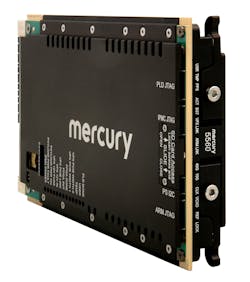Revving Up the Sensor Open Systems Architecture Edition 2.0
Check out more Technology Talks videos.
The Sensor Open Systems Architecture (SOSA) is an Open Group project that's designed to leverage open standards like VITA's OpenVPX for military and defense applications. These include Command, Control, Communications, Computers, Cyber, Intelligence, Surveillance and Reconnaissance (C5ISR) systems.
I talked with Mercury System's Rodger Hosking about the latest upcoming version, Edition 2.0, as well as the company's Model 5560 SOSA-compliant processing board (Fig. 1). The board is built around AMD/Xilinx's adaptive compute acceleration platform (ACAP).
The Model 5560 is a rugged, conduction-cooled OpenVPX (VITA 65) board with up to four 100-GbE interfaces plus additional 10- and 40-Gb interfaces (Fig. 2). It has optional VITA 67.3C optical connectors on the backplane. It's also compatible with VITA 46 and VITA 48.11. The board features an expansion mezzanine and 8 GB of DDR4 memory in addition to the 16 GB of high bandwidth memory (HBM) on the Versal chip.
SOSA is designed to allow for system upgrades through the use of standard components and software versus the more customized solutions of the past. It's been adopted by all U.S. military and defense groups as well as many outside the U.S.
Upgrading a system isn't necessarily a simple job. New hardware and software needs to be certified, but the standardization of backplane connections and interfaces, software connections, and so on make it possible to provide a newer solution that can be used with existing hardware and software in a modular fashion.
For example, on the hardware side, the OpenVPX standard provides slot definitions; the SOSA standard has incorporated a number of these, which reduces the number of possible VPX configurations. On the software side, platforms like the Object Management Group's Data Distribution Services (DDS) are part of SOSA.


